Is the average weather condition of an area recorded over a long period of time (over 30 years). The weather elements listed above are measured and recorded at a weather station. A weather station is an established area where daily records of weather are done accurately. Each weather station should have the following instruments; Thermometers which are kept in Stevenson screen that is maximum thermometers, minimum thermometers (six’s thermometer), dry bulb thermometer and wet bulb thermometers
THE MAIN DIFFERENCES OF WEATHER AND CLIMATE
|
WEATHER |
CLIMATE |
|
1. Is the condition of the atmosphere of a place at a particular time over a short |
-Is the average weather conditions of a region which have been observed over a long time |
|
2. Weather varies from one place to another within a region |
-Climate remains uniform overa large region |
|
3. Weather changes abruptly within a short period |
-Climate change is slow, gradual and occurs over many years |
|
4. There are weather instruments for measuring most of the elements of weather |
-Climate elements are not measured but calculated from the weather measurements |
edu.uptymez.com
Major Natural Regions of the World
Temperature on the earth’s surface varies from place to place. Place near the Equator usually have high temperatures throughout the year, while places near poles are cold throughout the years, similarly different areas on the earth’s surface receive different amounts of rainfall.
A place in South American, which gets the same amount of rainfall as a place in West Africa and has similar temperatures, will have the similar natural vegetation.
Likewise, people who live in the two areas under the same natural conditions carry out similar economic activities, for example, farming.
A region with the same geographical background to human activity such as temperature, rainfall and natural vegetation, is called a natural region, on this basis the earth’s surface may be divided into the following natural regions;
1. 1. Equatorial Region.
2. 2. Tropical Grasslands (Savanna).
3. 3. Monsoon Region.
4. 4. Hot Deserts.
5. 5. Mediterranean.
6. 6. Warm Temperature Eastern Margin (China type).
7. 7. Warm Temperature Interior Region (Steppe type.)
8. 8. Cool Temperature West Coast Margin (British type).
9. 9. Cool Temperature Continental Regional (Siberian).
10. Cold Temperature Eastern Margin (Laurentian)
11. Tundra and Polar Regions.
12.. Mountain Regions.
The Equatorial Region
The equatorial region is found approximately between latitude 00 and 50 North and South of the equator. Areas which belong to this type of natural region are the Amazon and Congo basins, the West Africa Coast, the East Indians and the Coastal plain Colombia.
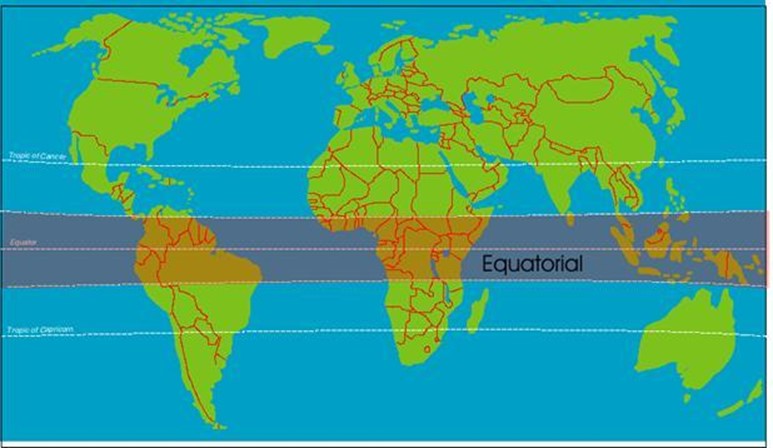
High temperature and very heavy rainfall characterize the region. The temperature varies little from 270c throughout the year. The annual range of temperature is generally small about 20c throughout the year. The total rainfall in these regions is around 2,000 millimeters with no distinct dry season. The annual nglish-swahili/distribution” target=”_blank”>distribution of rainfall usually shows two peaks (maximal) after the equinoxes fig 4.3, 4.4 and 4.5 and table 2(a) ,(b) and (c) demonstrates the climate of this region.
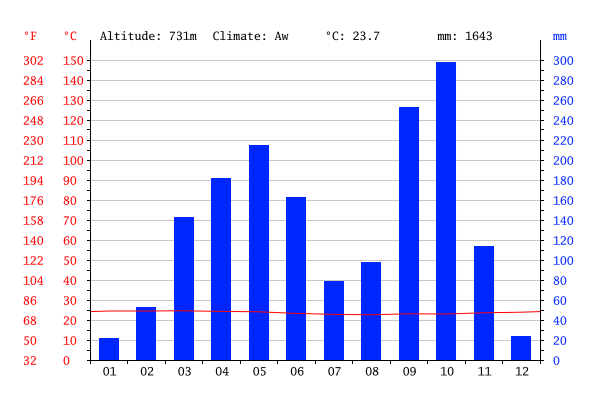
YAOUNDE
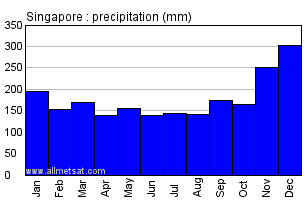
Singapore
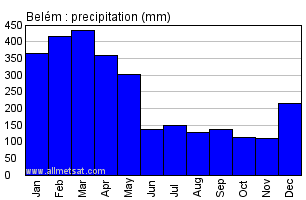
Belem
Table 2: Typical climate figures for the equatorial Region.
a) Yaounde (Cameroon)
|
Month |
J |
F |
M |
A |
M |
J |
J |
A |
S |
O |
N |
D |
Yearly |
|
Temp 0C |
25 |
25 |
24.6 |
24.5 |
24.2 |
24 |
24 |
24 |
24 |
24 |
24.4 |
24.5 |
24.3 |
|
Rainfall mm |
40.6 |
68.6 |
150 |
230 |
206 |
114 |
64 |
84 |
194 |
226 |
150 |
50.8 |
1579 |
edu.uptymez.com
b) Singapore
|
Month |
J |
F |
M |
A |
M |
J |
J |
A |
S |
O |
N |
D |
Yearly |
|
Temp 0C |
25.5 |
25.5 |
26.1 |
26.7 |
27.2 |
26.7 |
26.7 |
26.1 |
26.7 |
26.7 |
26.1 |
25.6 |
26.1 |
|
Rainfall mm |
246 |
180 |
185 |
198 |
65 |
178 |
170 |
198 |
175 |
201 |
256.5 |
264 |
2415.5 |
edu.uptymez.com
c) Belem (Brazil)
|
Month |
J |
F |
M |
A |
M |
J |
J |
A |
S |
O |
N |
D |
Yearly |
|
Temperature 0C |
25.5 |
25 |
25 |
25.5 |
25.5 |
25.5 |
25.5 |
25.5 |
26.1 |
26.1 |
26.7 |
26.1 |
25.5 |
|
Rainfall mm |
198 |
337.8 |
431.8 |
352.1 |
279.7 |
231.1 |
58.4 |
71.1 |
15.2 |
12.7 |
15.2 |
66 |
2275.8 |
edu.uptymez.com
Rainfall in this region is of the convectional type and is usually accompanied by thunder and lighting. Heavy rainfall, high humidity and high temperatures throughout the year result in continuous growth of vegetation’s. The natural vegetation in this region is thick forest called salve. The forest is always green, because the trees do not shed their leaves at the same time. The most common trees are mahogany, rosewood, ironwood, green heart balsa, palms and tree ferns.
The trees can grow to a height of 45 meters and their umbrella-like tops from and almost continuous cover of tree crowns (canopy). The trees are often intertwined with creepers (Lianas) and have many parasite plants. Because little light reaches the ground hence there is little undergrowth, where man has cleared the forest and practiced shifting cultivation, deserted areas develop secondary forests with mainly small trees and thick undergrowth.
There are three types of animals found in the equatorial rain forests. The first type consists of tree dwellers such as the gorilla, the chimpanzee and the monkey. These animals have long arms, which enable them to swing from branch to branch. In additional to these animals there are many varieties of birds, reptiles and insects. The second type consists of those animals which live in the rivers, such as the hippopotamus and the crocodile. The third type comprises animals that dwell in the open parts of the forest, especially where the forest merges into the Savanna.
People living in the equatorial regions usually engage in shifting cultivation or “slash and burn” agriculture. In this type of cultivation the people clear the forest by cutting down and burning the vegetation, then they tilt the soil and grow crops such as yams, cassava, groundnuts, maize, millet, sweet potatoes, sorghum, beans, water melon and banana. The major type of people in Amazon and Congo basin and East Indians are engaged in this kind of agriculture. They also do some hunting and fishing.
Another agriculture activity found in the equatorial region is plantation agriculture. A plantation is a large scale farm in which cash crops such as natural rubber, cocoa and oil palms are grown. Most rubber plantations are found in Malaysia, Indonesia, Thailand and Sri-Lanka. Natural rubber are of great importance to the economy of Malaysia and Thailand. It was equally important in the economy of Indonesia before oil was discovered. Rubber is used in making tires and in the manufacture of many industrial products.
Oil palm is another important crop grown in equatorial regions. It is grown in Nigeria, Malaysia and Indonesia. Palm oil is produced from the flesh of the fruit and from the nut. Palm oil is used for the manufacture of margarine, cooking fat and soap.
In Nigeria oil palm cultivation is widely spread in the South. The palm belt yields more palm produce than all the other parts of West Africa put together. The palm belt has ideal condition for growing palm. It has heavy annual rainfall about 1500mm, enough sunshine for opening the palm fruits, and well drained soils. Over 90% of the produce is obtained from small hold farmers, while the rest is obtained from plantations. Oil is extracted from the nuts by manual method or in oil mills.
Cocoa was introduced to the West Africa mainland from Fernando Po Islands in the last part of the 19th century. It has been developed by peasant farmers. At the beginning, the quality of cocoa was very poor as a result of lack of new technology in the preparation of the beans for export. Great improvements have been achieved following the grading of the cocoa beans and the payment attached to each grade. Ghana is the leading cocoa producing country in the world, with an annual output of about 250,000 tons.
A piece of land can be kept under cocoa cultivation for as long as 40 years. Preparation of the farms is done between January and March. Food crops are also grown on the cocoa farms during the first 4 years when the cocoa trees have not started to bear fruits.
Cocoa seedlings are easily damaged by directly sun rays and heavy rain. That is why a few trees are left when clearing the bush so that they may provide shades. More shades are provided by planting bananas.
Flowering begins in December and the main cocoa harvest takes place between October and February and the “light crop” is gathered from April to August. During the main harvest, owners of large cocoa farms are usually forced to hire labours to gather and tend upon the beans during fermentation. The quality of the crop depends largely on proper fermentation.
At home, men use sticks to split open cocoa pods. Inside each pod there are about forty beans lying in a bed for sticky white pulp. Women separate the beans from the pulp. Children help to carry them to the markets that are close to railway stations. From the markets the cocoa beans are transported by rail to Accra for export.
(Ghana Main cocoa producing area)
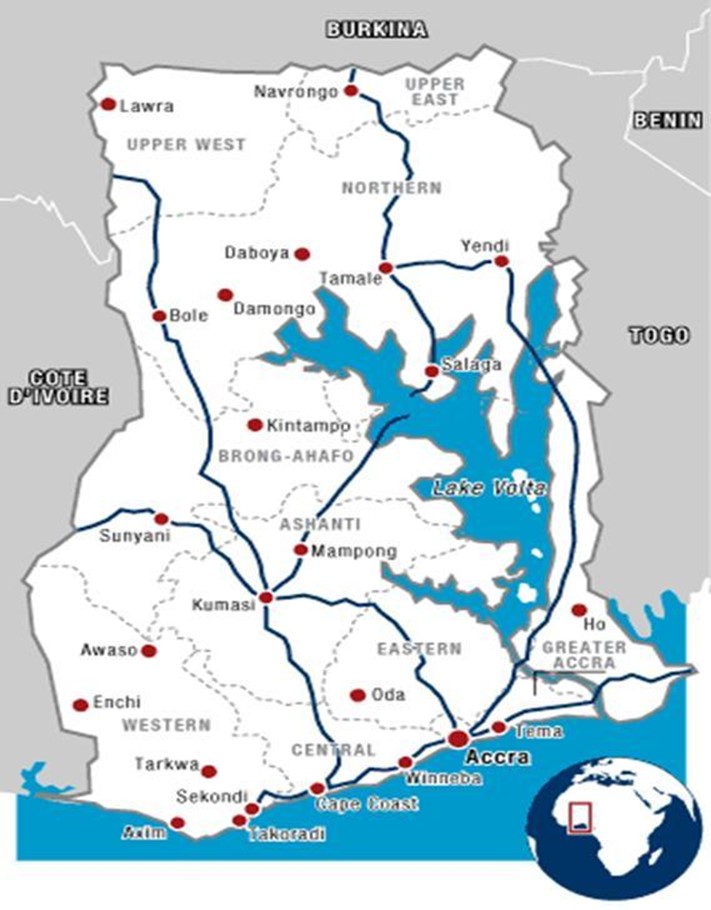
Lumbering in Ghana.
Ghana is among the west African countries that fall under equatorial type of climate. One of the economic activities carried in Ghana is lumbering. The forest and woodland used to cover about 33.1% of the total land use in Ghana. Up to date the forest land remaining is only a quarter of the former land. This is due to high exploitation of forests without replacement, which ennglish-swahili/courage” target=”_blank”>courage expansion of deserts and soil degradation. Forest management is under government control, which involves both natural forest and timber plantations.
The government ennglish-swahili/courage” target=”_blank”>courages timber production for export which employs about 70,000 people in the timber industry. A national Forestry Administration Program (NFAP) was established, supported by international bodies like USAID, the FAO and the countries such as Canada and the United Kingdom. Such programs do not realize the government’s irresponsibility in conserving the forests but to people who clear forests for new areas of farms land.
The falling of trees is through both man labour and use of machines. The trees are cut into logs and packed on the trucks then transported to the ports for export, and other to the home industries for processing. A part from lumbering people obtain traditional medicines, firewood, fruits and meet through hunting. These benefits are not realized by the government.
Tropical Grassland (Savanna or Sudan).
These regions are found between 50c and 200c north and south of the equator. They include West Africa, Sudan, East and Central Africa, the Brazilian plateau, Venezuela and North Australia.
Tropical Grassland or Sudan type
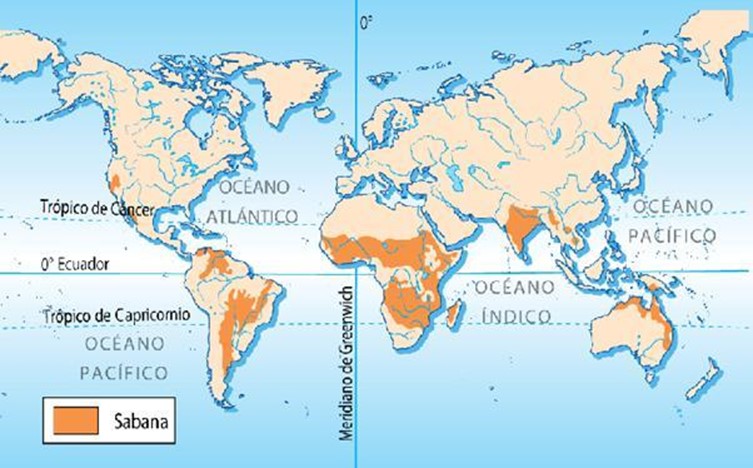
Temperatures are always high, but with a greater range than in the equatorial region. They range from 200C during the cool season and 320c in the hot season. This region has an annual range of temperature of about 80c. Total rainfall mainly during the hot season of the year (Tables 3 (a) and (b) and figure 4.9 and 4.10)
|
edu.uptymez.com
|
edu.uptymez.com
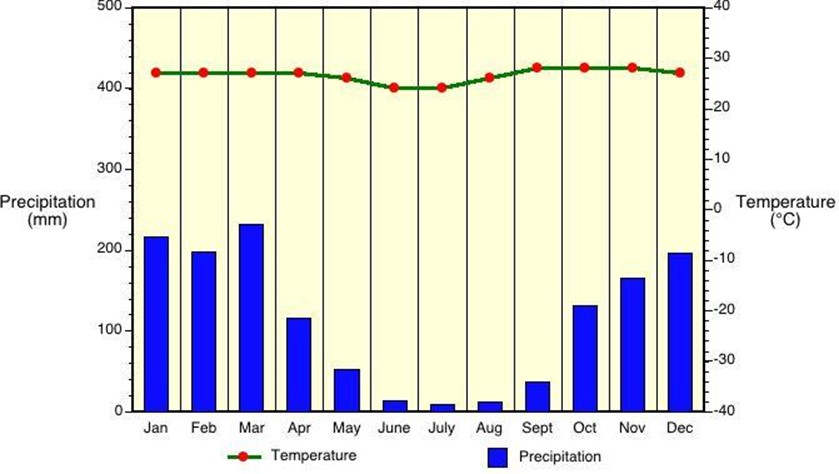
|
edu.uptymez.com
|
edu.uptymez.com
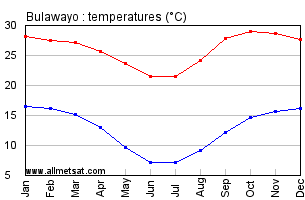
The vegetation varies considerably from the areas near the equatorial forest to the desert margin. The grass are tall and trees are more numerous in regions near the equatorial forests, but towards the desert margins the grass is short and poor and there are scattered thorn bushes. The grass grows well and becomes green during the rainy season but it turns yellow during the dry season. The grassland is known as the Campos while those in Venezuela are called the llanos. The African and Australian grasslands are known as the Savanna. The Savannas are the most extensive grasslands.
Table 3: Typical climate figures for the Tropical Grassland (Sudan type) Region.
a) Cuiba (Brazil)
|
Month |
J |
F |
M |
A |
M |
J |
J |
A |
S |
O |
N |
D |
Yearly |
|
Temp 0C |
27.2 |
27.2 |
27.2 |
26.7 |
25 |
23.9 |
24.4 |
25.5 |
27.8 |
27.8 |
27.8 |
27.2 |
26.7 |
|
Rainfall mm |
248 |
211 |
211 |
101.6 |
53 |
7.6 |
5 |
28 |
50.8 |
114 |
149.9 |
205.7 |
1386.6 |
edu.uptymez.com
(b) Bulawayo (Zimbabwe)
|
Month |
J |
F |
M |
A |
M |
J |
J |
A |
S |
O |
N |
D |
Yearly |
|
Temp 0C |
21.7 |
21 |
20.6 |
18.9 |
16.0 |
13.9 |
13.9 |
16 |
20 |
22.2 |
22.2 |
22.2 |
19.2 |
|
Rainfall mm |
149.7 |
101.6 |
78.7 |
17.8 |
7.6 |
0 |
0 |
0 |
2.5 |
22.9 |
83.8 |
132 |
599.4 |
edu.uptymez.com
Typical trees of the Savanna grasslands are baobabs, miambo, acacias and gum trees. Two main groups of animals found in the Savanna include the grass and leaf eating animals such as giraffe, elephant, buffalo, hippopotamus, zebra, antelope and rhino. Animals which feed entirely on plants are known as herbivorous animals.
The second group consists of the fresh eating or carnivorous animals such as the lion, leopard and hyena. In addition, there are many species of birds, Reptiles and insects.
People in the tropical grassland engage mainly in livestock keeping and cultivation. In the Campus of Brazil, cattle are grazed on large farms called ranches. Cattle rearing is also important in the llanos of Venezuela and Savannas of Africa.
The main crops grown in the tropical grasslands are maize, millet, groundnuts, rice, beans, onions, cotton, tobacco, sugarcane, sisal and coffee. Maize and millet are the two most important food crops. Maize grows well in the wet areas while millet thrives in the drier parts. Groundnuts are important crops in West Africa. In Brazil and other tropical high land, coffee is grown mainly on plantations. Cotton is widely grown throughout the tropical grassland on small peasant plots.
Most of Tanzania lies in the tropical grassland. In this part of the country livestock keeping is one of the major occupations of the Sukuma and the beans are growing mainly for food by the majority of Tanzanians. Coffee, Cotton, Tobacco are grown in various parts of the country as cash crops.
Cotton Growing in Sukuma land
Cotton is one of the important cash crops in Tanzania. Over 90% of the outputs comes from areas around Lake Victoria, specifically Mwanza and Shinyanga regions. These are usually referred to as Sukumaland and it is inhabited by Sukuma tribe. Other areas together produce about 10% of the country’s total output.
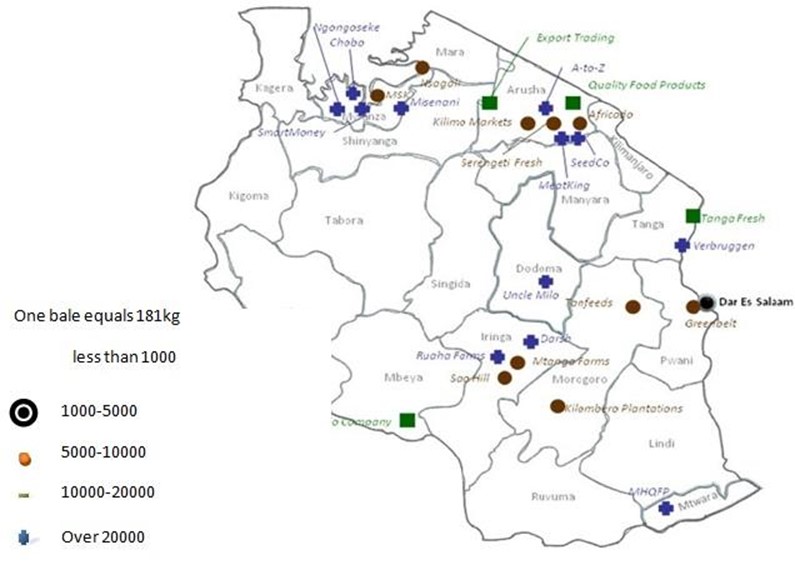
Cotton production 1990-1999
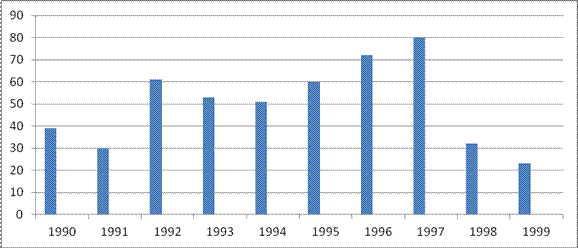
Cotton growing in sukuma land started in Mwanza and Kwimba districts, and later spread into the surrounding areas of shinyanga, Maswa and Geita. These new areas had a small population but a lot of flat land. This made large scale cotton farming possible. People also grow cassava, maize and rice mainly for subsistence.
In sukuma land rainfall is seasonal and has great influence in cotton growing. Both the total annual rainfall, which is between 508 millimeters and 884 millimeters, and the monthly nglish-swahili/distribution” target=”_blank”>distribution are of great importance to the quality and quantity of cotton produced.
Table 4. Rainfall Data: Average Monthly totals
|
Month |
Station |
||
|
|
Geita (Boma station) mm |
Maswa Banagi Hill station mm |
Maswa ( Gulu Station) |
|
October |
85.80 |
30.75 |
8.64 |
|
November |
136.91 |
75.18 |
43.94 |
|
December |
122.43 |
88.14 |
99.82 |
|
January |
101.6 |
75.95 |
100.84 |
|
February |
884.58 |
78.23 |
98.55 |
|
March |
121.16 |
116.59 |
119.63 |
|
April |
156.21 |
119.63 |
85.34 |
|
May |
87.63 |
61.72 |
37.59 |
|
June |
11.18 |
30.99 |
0.00 |
|
Jully |
1.02 |
24.38 |
0.00 |
|
August |
12.45 |
42.93 |
0.00 |
|
September |
32.00 |
35.56 |
0.64 |
|
Total |
1752.97 |
780.05 |
594.99 |
edu.uptymez.com
GRAPHS
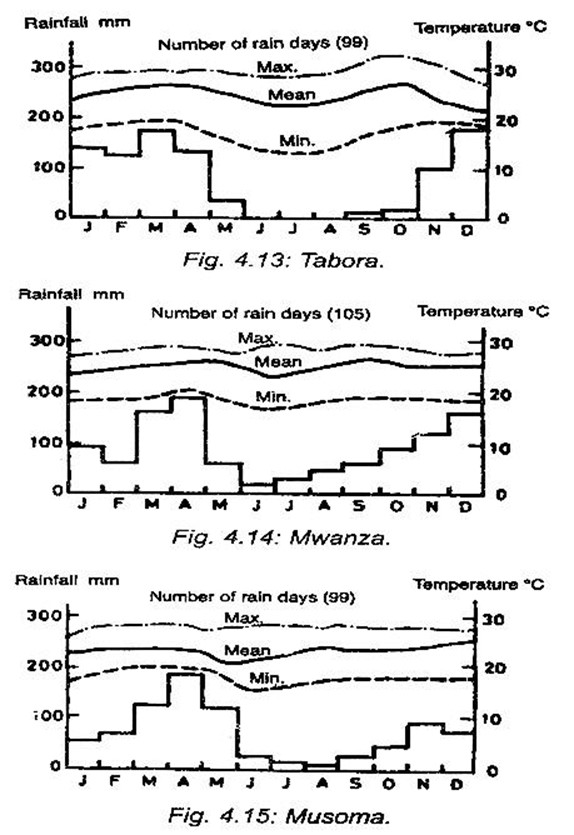
Generally Mwanza Region has an altitude varying from 1,128 meters to 1,280 meters. Suitable land for growing cotton in Mwanza area occurs in patches in the up lands partly because there is a lot of rocky land in this area and partly because the bottom lands are more suitable for grazing. In Mwanza region cotton fields are usually cultivated by family members. They cultivate the farm in strips down the slopes around the hills.
Shinyanga region has been more recently settled than Mwanza region. Cotton farms in this area are quite extensive because the land is flat and the farmers use tractors or plough and hire labour during weeding and harvesting peaks. Geita district is the only district in Mwanza region which engages in extensive farming similar to that found in Shinyanga region.
Labour patterns in both Mwanza and Shinyanga regions follow a similar sequence. For example, a generalized working pattern in Geita district in Mwanza and that of Maswa district in Shinyanga is as follows;
|
Activity |
Geita- (Mwanza) |
Masura (Shinyanga) |
|
1. First significance cultivation |
Early October |
Late November |
|
2.Cultivation peak |
Late November |
Late December |
|
3. Weeding peak |
Early January |
Early February |
|
4. Harvesting peak |
Mid June |
Early July |
edu.uptymez.com
· In Maswa farmers generally begin to cultivate soon after the first rains. Their working calendar on the cotton farms is as follows;
November- Mid December
· Clearing the fields.
· Ploughing and spreading manure or fertilizer.
· Collecting seeds from primary societies (about two and a half tons per hectare).
· Planting.
Mid December- March
· Thinning the seedlings.
· Weeding (done three to four times).
· Spraying (done three to four times).
May – July
· Harvesting
· Sorting and grading
June – August
· Selling.
August – September
· Uprooting and burning the cotton plants. Most farmers do the ploughing and planting at the same time at the beginning of the rainy season.
Weeding is done at least three times. The first weeding is done when the cotton seedlings are seven to ten centimeters tall. This helps the seedling grow healthy and strong because they get enough supply of food and in clean fields. The second weeding is done before the cotton balls open and spraying is done after each weeding to clear off any cotton disease.
The harvesting period is the busiest time for the whole family, usually harvesting is done between May and July. The beginning and the end of harvesting will depend on when each individual farmer planted his cotton. But harvesting peaks occur between the last week of June and the first week of July. After harvesting peaks occur between the last week of June and the first week of July. After harvesting, Farmers immediately uproot the cotton plants and burn them. Burning help to kill the cotton pests that might have attacked the cotton plants. The farms are left clear of any cotton plants ready for the next ploughing period.
Livestock Raising in Tanzania.
Livestock raising in Tanzania include pastoralism, mixed farming and ranching. Pastoralism is an activity of keeping animals such as cattle, goats and sheep’s. The pastoralists in Tanzania include the Masai and Barbaigs who move from one place to another searching for pastures and water for their animals. Normally they don’t have permanent settlements. These are pure pastoralists with large herds of animals.
Ranching is a commercial way of keeping animals. The animals are kept in an enclosed big area with necessary facilities. Ranches in Tanzania involve beef cattle, piggery and large poultry projects. Some of these ranches can be found in Kongwa District in Dodoma, Kikombo in Mpwapwa District. Ruvu in Kibaha District and west Kilimanjaro in hai District. The government or companies today run most of these ranches.
Mixed farming is a kind of farming whereby people with permanent settlement keep animal and involve in crop cultivation. Good examples are the Sukuma, Nyamwezi and Gogo. Few cattle herders in Tanzania practice transhumance that is seasonal movement with cattle up to the highlands and down the valleys especially during dry seasons. The good examples of such movements are the pare who move with herds to the uplands during a day time and back to their homes in the evening.
Exercise.
Draw a map of Tanzania and show the areas with large number of animals keepers
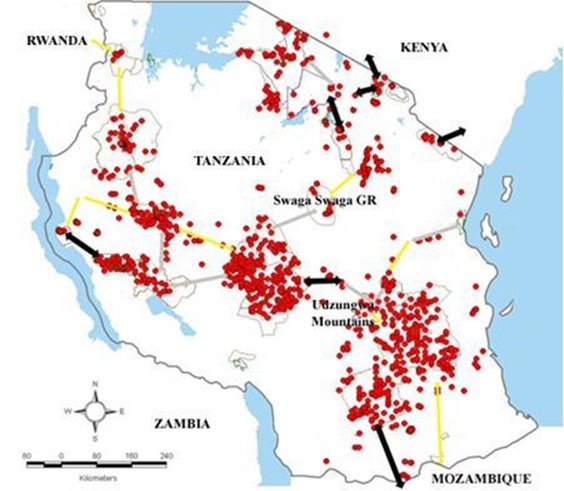
Monsoon Region
It was pointed out that the word monsoon comes from an Arabic word “Mausin” which means season. The monsoon region is an area in the climate mainly influenced by the wind blowing alternatively from one direction in one season and the other direction in another season. The areas which have monsoon type of climate are South East (India, Pakistan, Burma, Thailand and China) and Northern Austria. This type of climate is mostly marked in India.
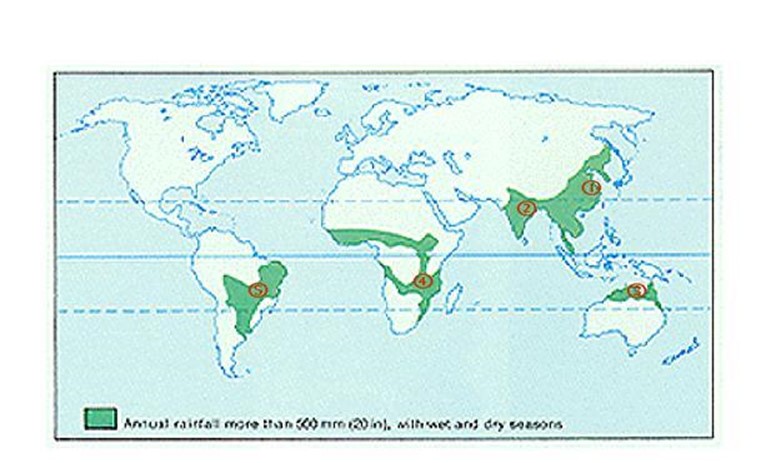
In winter, the interior of Asia is extremely cold. The air over this area is cold and heavy, forming a region of high pressure without blowing winds. But the sea is comparatively warm, for it has been gradually gaining at during summer and warm air over it rises, forming a region of pressure. Wind blows from the high pressure area in the interior towards the low pressure area over the sea. Since the winds which blow from land are dry, the monsoon lands receive little rain during winter except for it in coastal areas and island such as sri-lanka which are reached the winds after passing over the ocean. In summer the opposite happen. Except for very high areas, the interior of Asia becomes extremely cold. The air over the land becomes intensively heated, expand, rises and form a region of low pressure. Since the sea takes longer to heat than land does, the sea becomes comparatively cool, and forms an area of high pressure. Winds blow from the sea to the land and bring rain to South East Asia. Over most India Rain bearing winds blow from the south west. In china South East winds blow from the Pacific ocean.
The amount of rainfall the monsoon region receives varies from place to place. For instance, charrapunji, on the wind ward side of the khusi hill in Assam (India), gets around Delhi (India) receives only 620 millimeters of rainfall (Table5 (a), (b) and (c) and fig. 4.17, 4.18 and 4.12.
Table 5: Typical climate figures for the Tropical Monsoon Region;
a) Bombay ( India)
|
Month |
J |
F |
M |
A |
M |
J |
J |
A |
S |
O |
N |
D |
Yearly |
|
Temp 0C |
23.8 |
23.8 |
25.5 |
26.8 |
29.2 |
22.4 |
26.4 |
26.3 |
26.3 |
27 |
26.1 |
26.3 |
26.1 |
|
Rainfall mm |
2.5 |
0.0 |
2.5 |
0.0 |
17.8 |
523 |
693 |
406 |
299 |
60 |
10 |
0.0 |
2016.7 |
edu.uptymez.com
b) Darwin (Australia)
|
Month |
J |
F |
M |
A |
M |
J |
J |
A |
S |
O |
N |
D |
Yearly |
|
Temp 0C |
28.9 |
27.8 |
28.9 |
29 |
26.7 |
26 |
25.1 |
26.1 |
28.1 |
29.7 |
29.8 |
29.5 |
28.1 |
|
Rainfall mm |
388.6 |
330.2 |
246.4 |
114 |
17.8 |
5 |
2.5 |
2.5 |
12.7 |
53.3 |
132 |
261 |
1554.5 |
edu.uptymez.com
c) Hong Kong
|
Month |
J |
F |
M |
A |
M |
J |
J |
A |
S |
O |
N |
D |
Yearly |
|
Temp 0C |
15.4 |
14.3 |
17.2 |
21.1 |
25 |
26.1 |
26.7 |
26.7 |
26.1 |
24.4 |
20.6 |
17.2 |
22.2 |
|
Rainfall mm |
35.6 |
27.9 |
66 |
139.7 |
259 |
383.5 |
289.6 |
355.6 |
292.1 |
114.3 |
40.6 |
33 |
2169.5 |
edu.uptymez.com
The monsoon region has three marked Season. The hot dry season starts from March to June and has temperatures rising to over 320c, hot wet season which starts from October to March. Fig 4.17, 4.18 and 4.19 Show rainfall and temperature conditions for three stations in the monsoon region;
|
edu.uptymez.com
|
edu.uptymez.com
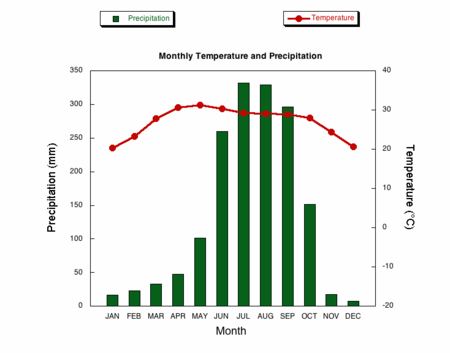
|
edu.uptymez.com
|
edu.uptymez.com
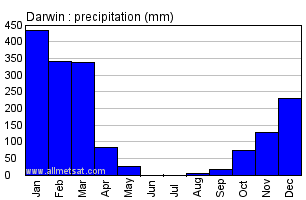
Hongkong
There is very little of the natural vegetation left in the monsoon areas. However, the main natural vegetation types still existing vary with the amount of rainfall. Where there is very heavy rainfall (over 2000mm) vegetation consists of forests with trees such as teak and tropical cedar, .the trees grow to a height of about 30 to 35 meters. Where rainfall is relatively heavy (1000-2000mm) less dense forests are found. The trees include iron, wood and sandal wood. Mangrove trees grow in swampy coasts and many reaching a height of nine meters. Deciduous any trees such as tamarack and acacias are another type of vegetation found in this region. This vegetation is found in their desert of India. Because of population pressure in India, a lot of land which is reserved for wild animals have been used for human settlement. As a result of luck of natural habitats many wild animals have disappeared. Among the animals that have survived are the tigers, the hyenas, and the elephants
About 70 percent of the population in Asia are farmers. Because of the high density of population in many parts of Asia most farms are small in size and are intensive. Rice is the most common food crop and is the staple food for most people in the wetter parts of India, Bangladesh, Burma and indo- china. Wheat, millet, maize and sorghum are grown in the drier areas where rice cannot be grown, and are important crops in the northern India and Pakistan. Sugarcane, cotton and jute are important in lower land crops in India, Pakistan and Bangladesh. Tea is grown in highland areas as a plantation crop particularly in Sri-lank, Bangladesh and India.
Pigs, cows, buffaloes, sheep, goats and poultry birds are raised in this region. India has a large number of cows but a cow is regarded as a sacred animal by the Indians and it is therefore not kept for meat. Cattle is kept for milk and for ploughing. Large urban centers in the region have developed as major industrial centers.
Paddy growing in India.
Rice is the staple food to the people of India. It is grown in the tropical lowland where rainfall exceeds 1780mm per year. it is the most characteristic crop of the monsoon lands and the total coverage exceeds that of any other crop. Paddy is cultivated in very few areas outside the influence of the monsoon.
The factors for paddy growing include heavy rains which exceed 1780mm per year. The alluvial type of soil brought by rivers and ice melt from the Himalayas increase fertility to the soil. Water logging in the flooded areas is also another factor for paddy growing, the additional water through irrigation from the Punjab irrigation schemes, wells and canals increase yielding of paddy in India. In areas with less amount of rainfall below 1780mm allow growing of paddy where as the wet paddy is grown in the heavier amount of rainfall.
The land holding is for subsistence and plantation. The subsistence is mainly for family consumption where excess is sold to the rural cooperatives. The farmers use oxen borrowed from the land owners or cooperatives to plough the paddy field and harvest by hand using seasonal cheap laboures. In the plantations, they use tractors and often oxen to plough the paddy fields. The tractors are owned by the government and foreign companies. They apply fertilizers and insecti sides to improve high yields of the crop. In harvesting they use seasonal or migrant laboures and combined harvesters. A large part of the harvest is for selling.
The Hot Deserts
Hot deserts are found on the western margins of land masses between latitude 200 and 300 north and south of the equator (fig.4.20). hot deserts occupy about one third of the earth’s surface. The major hot deserts of the world are, the Sahara, the Kalahari and the Namibian deserts in Africa, the California deserts( north AMERICA), the Alabama desert(south America), the Arabian, thar and Gobi deserts in Asia and the great Australia desert.
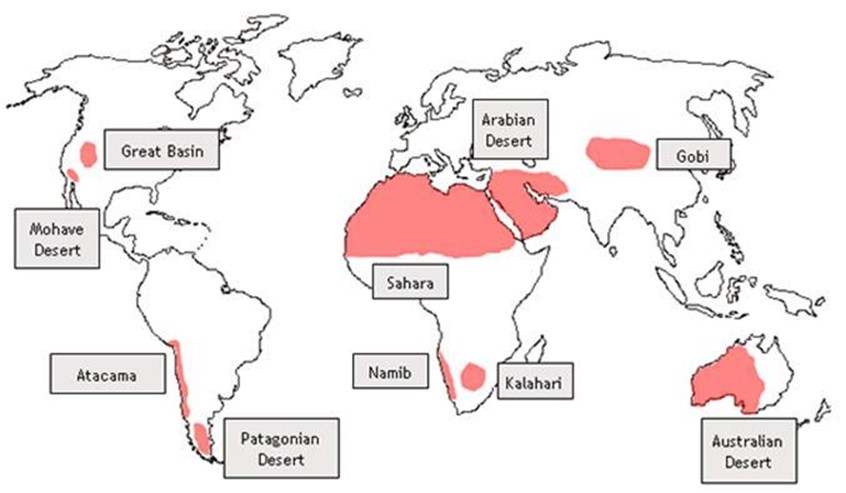
The desert surface varies from desert to desert and from place to place within the same desert. On the basis of types of surfaces deserts are classified as:
1. Sand deserts these have sand surfaces and are sometimes known as ergs.
2. Stony deserts where stones prevail. Such deserts are also called series or regs.
3. Rocky deserts (Hamada) which have rocky surfaces. Hot deserts have high temperatures and very low rain fall (fig. 4.21, 4.22, and tables a,b, c.)
Table 6.typical climatic figures for hot dessert regions.
a) Insalah (Algeria)
|
Month |
J |
F |
M |
A |
M |
J |
J |
A |
S |
O |
N |
D |
Yearly |
|
Temp 0C |
13.3 |
6.1 |
20.0 |
25 |
28.9 |
35 |
36.7 |
35.8 |
32.8 |
26.7 |
19.1 |
14.4 |
23 |
|
Rainfall mm |
2.5 |
2.5 |
0 |
0 |
0 |
0 |
2.5 |
0 |
0 |
5.0 |
2.5 |
15.0 |
50 |
edu.uptymez.com
B) Lima (Chile)
|
Month |
J |
F |
M |
A |
M |
J |
J |
A |
S |
O |
N |
D |
Yearly |
|
Temp 0C |
21.7 |
22.8 |
22.8 |
21 |
18.9 |
16.7 |
16 |
16 |
16 |
16.7 |
18.9 |
21 |
18.9 |
|
Rainfall mm |
0 |
0 |
0 |
0 |
0 |
5 |
7.6 |
12.7 |
12.7 |
2.5 |
0 |
0 |
45.7 |
edu.uptymez.com
b) Windhoek (Namibia)
|
Month |
J |
F |
M |
A |
M |
J |
J |
A |
S |
O |
N |
D |
Yearly |
|
Temp 0C |
23.3 |
22.8 |
21.1 |
18.9 |
15.6 |
13.3 |
12.8 |
15.6 |
18.9 |
20.6 |
22.2 |
23.3 |
19 |
|
Rainfall mm |
68.6 |
68.6 |
81.3 |
43.2 |
10.1 |
0.0 |
0.0 |
0.0 |
2.5 |
10.1 |
25 |
45.7 |
256.5 |
edu.uptymez.com
In most deserts, day time temperatures are very high around 400C. Nights are cold with temperatures as low as 160C. In winters the night temperatures may fall to 500C. The daily range of temperatures is large (160C) for example in Egypt the mean monthly temperature in summer is 320C in winter months the temperature may be as low as 160 C.( table 6 figure 4.21,4.22 and 4.23)
|
edu.uptymez.com
|
edu.uptymez.com
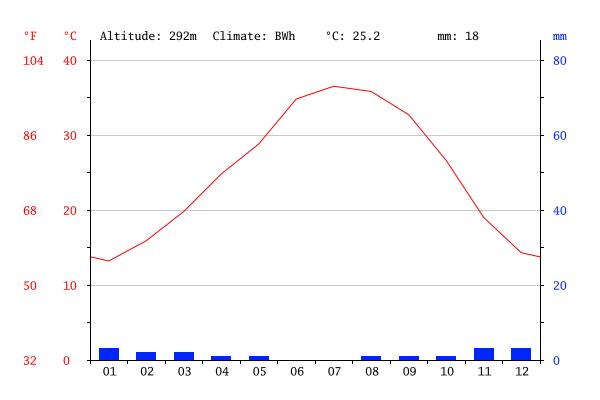
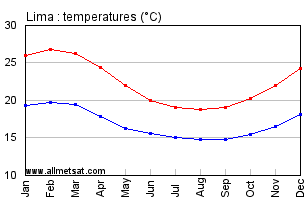
|
edu.uptymez.com
|
edu.uptymez.com
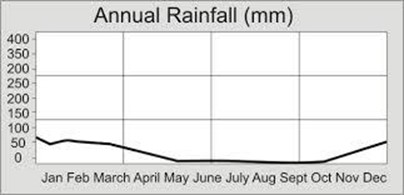
Deserts get very little rain usual less than 250mm. in some deserts rain may fall only once in five or six years.This type of rainfall is heavy and collects into stream of running water which may form channels. When sub channels are dry they are called wadis.
In some cases for example in the Sahara strong winds such as harmattan blow across the desert. These winds carry a lot of sand and dust. Such sandstones are usually called simoom.
Natural vegetation is very scanty in hot deserts and it consists mostly therny scrub bushes and cactus. Wherever agriculture is practiced the crops that are grown include date palm, cotton, rice, sugarcane ,vines, millet, tomatoes , tobacco and fruit trees. Apart from people who live in these Oases there are nomads who move from place to place to search for pastures. They keep camels, donkeys, and sheep. Other desert people get their food from hunting and collection of nuts and fruits. Other occupations include weaving mats, making tents and ropes and also trading.
Meaning of desert:
Desert refers to an area which receive low amount of rainfall approximately 250mm per year.
Life in the oasis.
In the deserts wherever there are oases some forms of settlements is bound to follow. These are depressions of varying size when underground water reaches the surface for example tufted oasis in morocco covers 13000 square kilometers which supports many settlements, including big towns. Other oasis include ghadermes oasis in Libya which is only 2.6 Square kilometers in size and supports a very low population.
Life in an oasis is very secured and well organized. A wall usually constructed around the oasis to keep out the violent storm dusts called simooms. In the oasis people live in mud bricks houses with flat roofs closely packed together. The streets are narrow and winding (run around the oasis). The heart of the settlement is dominated by the suas May (normal market place), mosques, schools and shopping blocks. Suas may also be set up several kilometers from anywhere and people come from a number of surround settlement on special days to trade.
Around the settlement is the agricultural land. Most of the crops produced are through irrigation channels or drawn water from wells by camels or mules. The important crops include date palm, others are maize, barley, wheat, cotton and sugarcane, fruits and vegetations.
Importance of deserts to the economy.
Desserts are important for the production of date palms, cotton, sugarcane and wheat which are raw materials to the world’s industries. Useful animals are also reared in the deserts and they walk long distances without eating and drinking. They serve people in transport all over the world as they are the cheapest means of transport. These animals include camels and mules. Valuable minerals deposits (Mining) are found in the deserts for example gold, caliche (cemented groves), copper, sodium nitrate, silver, diamond and uranium which are very important raw materials in the world’s industries for different purposes.
Apart from the above mentioned minerals, oil production and the desert. Most of the petroleum used in the world is obtained from deserts. Petroleum serves as lubricant as fuel for road construction and domestic uses and as raw materials in oil refined industries.
Desert formation expansion and control.
Desserts are formed by both man’s activities and natural forces, that influence desert formation which include drought which is a result of long experiences of low amount of rainfall or caused by man’s activity which is made more acute by population increase.
Population increase ennglish-swahili/courage” target=”_blank”>courages deforestation for various reasons. Over grazing, use of unskilled labour, irrigation and over occupation. Desert expansion can be checked through changing people‘s attitude by planting trees after cutting one, use of proper methods of irrigation, reducing the number of animals in one area avoid mono cropping by crop rotation and control population that exceeds resources available.
Revision.
Answer all questions in this section.
Read the following statements carefully and then write the letter of the most correct answer below in the space provided against the question.
1. One of the following groups are features of the ocean floor.
a)Continental shelf, continental slope, trench.
b)Trench, ridge, basin, dune.
c) Horst, plain, volcano, basin.
d)Ridge, basin, plateau and water fall
2. One of the effects of rapid population growth on small scale agriculture is?
a) Low technology.
b) Land degradation.
c) Decline in soil fertility
d) Population pressure.
3. What will be the temperature of musindi at 1800 meters above sea level, if the temperature of tanga at sea level is 340c?
a) 2-820c
b) 49-80c
c) 28-20c
d) 10.80c
4. Eclipse of the moon( lunar eclipse) takes place
a) When the earth is in between the sun and the moon
b) When the meteors fall on the moon.
c) When the moon is above the sun.
d) All the above answers are correct.
5. Which of the following mathematical statement given is the right answer in minutes of the time taken by earth to turn one degree of longitude?
a) 3600 x24 hours
60
b) 24 hours x60 minutes
360
c) 3600
60minutes
If the time of maputo 500e is 3:00pm, when the time at Lagos is 12:16 pm, what is the longitudinal position of Lagos?
a) 610e
b) 900e
c) 440e
d) 900e
Pick out the statement that is not true.
a)All altitude is a great circle
b) All longitudes are great circles
c) All longitudes and equators are great circles.
d)Greenwich meridian is a meridian 1800
The structure of the earth is composed of:
a) Sima and sial.
b) Carbon and sodium
c) Silicon and alumina
d) Crust, mantle and core
Which of the following statements is not true for an equatorial region?
a) It is found in between 0 0and 50 north and south of equator
b)It has two rainfall maximum
c) It has small temperature range
d)It has temperature of above 400c
Match the items in column A with corresponding items in column A by writing the letter of th correct item in column B against its corresponding number in column.
i. Meteors (I)
ii.Water pollution (E)
iii. Isotherms (N)
iv. Aneroid barometer (K)
v.The period when earth becomes nearest to the sun (O)
vi. Scale (F)
vii. The cause of day and night(C)
viii. Mozambique ocean current(H)
ix. Volcanic mountains( G)
Column B
a)Has not erupted recently
b)Mbozi in mbeya region and tandura in Ruvuma region
c)Rotation of the earth
d) Cola ocean current
e) Unwanted substances mixed with water
f)Distance on the map to the actual distance
g)Rungwa in mbeya and Kilimanjaro
h)Warm ocean current
i) Piece of hard matter falling from the outer space
j) Aplolion
k) An instrument used to measure air pressure
l) Restoration of wasteland in productive land
m)Chemical added to water to purify it
n) Lines joining places with the same temperature
o) Perihelion
p) Revolution of the earth
q) Lines joining places with the same air pressure
r) Is the result of earth’s wrapping.
Calculate the total annual rainfall
100
80
70
60
40
16
20
60
10
90
546+70=606 total annual rainfall is 606mm
To suggest the type of climatic region for station x give the reasons;
This is the tropical region
Because it has more rainfall 500mm-1500mm
It has above two degrees centigrade
In which hemisphere is the station located?
Southern hemisphere
Suggest two types of crops grown in this area.
a) Banana
b) Coffee
List down four elements of weather
a) Clouds
b) Winds
c) Humidity
d) Pressure
Write true or false against statements given below.
i. The small stream joining together to form a main river is called a distributary false
ii. Pastoralism is the seasonal movement of live stock to the mountains and to the valleys. True
iii. A forest is a renewable source. True
iv. Contour terracing is an agriculture aim to prevent loss of soil fertility. False
v. In shifting cultivation permanent crops like coffee, cocoa and banana are grown. False
vi. All longitudes are great circles. True
vii. Mining activities can destroy the environment. True
viii. Lake nyasa is an example of a lake created by aman. False
ix. Kagera river basin is one of the major sources of the Nile contributing 30% of its water. False
Mediterranean regions.
The mediteranean type of climate is found in areas between 300 and 450 in the northern hermisphere and between 300 and 400 in the southern hermisphere.Places with the Mediteranean climate are the coastal lands around the mediteranean sea (the maghreb, spain, italy, greece, egypt, and israel), the western sides of north and south america (central califonia and central china), Australia (south and western) and south africa (cap province)
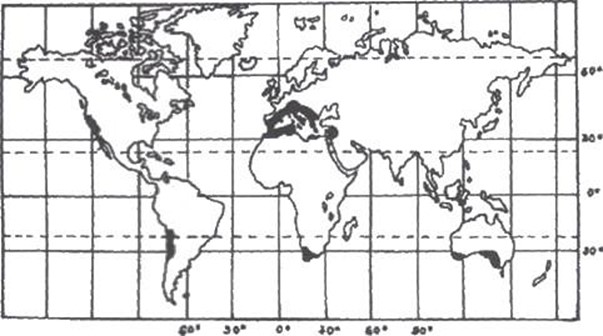
In the summer these areas are hot and dry because they are under the influence of trade winds. In the winter, westerlies from the ocean bring rainfall to these areas. Rainfall is relatively light and the annual total varies from 500mm to 760mm. temperatures range from 210C in summer to about 100c in winter.
|
edu.uptymez.com
|
edu.uptymez.com
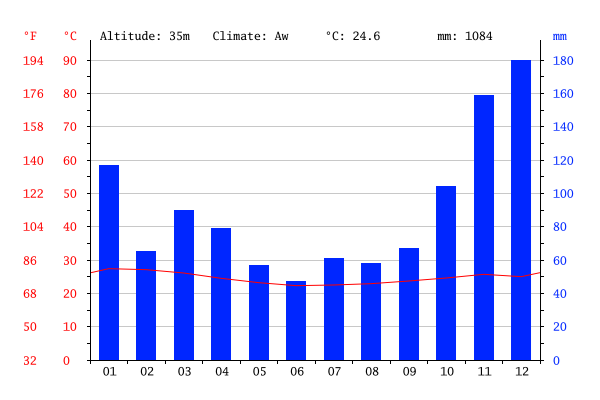
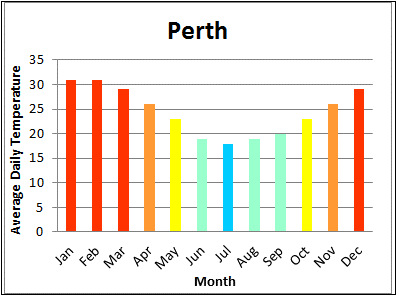
|
edu.uptymez.com
|
edu.uptymez.com
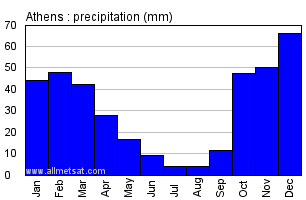
|
edu.uptymez.com
|
edu.uptymez.com
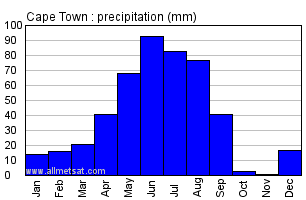
There is little natural vegetation left in the Mediterranean region because much of it has been cleared for cultivation of commercial crops such as citrus fruits.
Since little rainfalls during the growing season, plant life in these areas is adopted to summer drought by storing in thick barks and leaves moisture derived from winter precipitation. The plants also have small waxy, spiny leaves which prevent excessive transpiration. Some of the common trees found around the shores of the Mediterranean sea are cork-oaks, cypress and cedar. where forests have been cleared for cultivation and no trees are spared. In areas that have been mostly developed for cultivation scrub land of ever green shrubs such as cleander, lavender, rose marry and thyme are found in California. The douglasfir, is the most common tree, where as in Australia eucalyptus is the most common tree.
Table 7; typical climatic figures for the Mediterranean region.
a) Valparaiso (Chile)
|
Month |
J |
F |
M |
A |
M |
J |
J |
A |
S |
O |
N |
D |
Yearly |
|
Temp 0C |
17.8 |
17.2 |
16.1 |
14.4 |
13.3 |
11.1 |
11.1 |
11.7 |
12.2 |
13.9 |
15.6 |
16.7 |
14.4 |
|
Rainfall mm |
0.0 |
0.0 |
22.9 |
2.5 |
68.6 |
152.4 |
134.6 |
86.4 |
10.2 |
12.7 |
7.6 |
0.0 |
497.8 |
edu.uptymez.com
b) Perth (W.Australia)
|
Month |
J |
F |
M |
A |
M |
J |
J |
A |
S |
O |
N |
D |
Yearly |
|
Temp 0C |
22.8 |
23.3 |
21.7 |
18.9 |
15.6 |
13.3 |
12.8 |
14.4 |
14.4 |
16.1 |
8.3 |
21.7 |
17.8 |
|
Rainfall mm |
7.6 |
7.6 |
17.8 |
43.2 |
124.5 |
167.6 |
162.6 |
142.2 |
83.3 |
53.3 |
20.3 |
15.3 |
845.8 |
edu.uptymez.com
c) Antherns (Greece)
|
Month |
J |
F |
M |
A |
M |
J |
J |
A |
S |
O |
N |
D |
Yearly |
|
Temp 0C |
9.1 |
9.7 |
11.2 |
14.8 |
19 |
23.5 |
26.6 |
26.4 |
23 |
18.9 |
14 |
11.2 |
17.3 |
|
Rainfall mm |
50.8 |
38.1 |
33.0 |
20.3 |
20.3 |
17.8 |
7.6 |
10.2 |
15.2 |
43.2 |
73.7 |
61 |
391.2 |
edu.uptymez.com
d) Algiers (Algeria)
|
Month |
J |
F |
M |
A |
M |
J |
J |
A |
S |
O |
N |
D |
Yearly |
|
Temp 0C |
9.4 |
10.0 |
11.1 |
1.3 |
16.1 |
20 |
22.8 |
23.9 |
21.1 |
17.8 |
13.9 |
11.1 |
16.1 |
|
Rainfall mm |
101.6 |
66 |
83.8 |
50.8 |
43.2 |
17.8 |
2.5 |
2.5 |
30.5 |
86.4 |
104.1 |
101.6 |
696.0 |
edu.uptymez.com
e) Cape Town
|
Month |
J |
F |
M |
A |
M |
J |
J |
A |
S |
O |
N |
D |
Yearly |
|
Temp 0C |
21.1 |
21.1 |
20 |
17.2 |
15 |
13.3 |
12.8 |
13.3 |
14.4 |
16.1 |
17.8 |
20 |
16.7 |
|
Rainfall mm |
17.8 |
15.2 |
22.9 |
48.3 |
96.5 |
114.3 |
94 |
86.4 |
58.4 |
40.6 |
27.9 |
20.3 |
642.6 |
edu.uptymez.com
The climate permits a wide range of crops to be grown these include fruits and cereals. The most common cereals are wheat, barley, maize,and citrus fruits (oranges, lemons, limes.), olives and grapes. Other fruits are peaches, apricots, plums, cherries and pears. Farmers use both ploughs and hoes. Fields are terraced in order to conserve soil and rain water to sink into the ground. In hot districts such as south Spain and Sicily, rice, sugarcane, oranges and lemons are grown in irrigated areas. Agricultural based industries that have developed these areas include wine making, flour milling and fruit.
Fruit growing in south Africa.
The cultivation of fruits seems to be the oldest agricultural activity in South Africa which started as a source of supplying citrus to the passing ships of Dutch east India company to prevent scurvy among the crews. However interests soon shifted to grapes which were converted into wine which stood too long in sea journeys.
Citrus fruits were mainly grown for local markets. When the Boer farmers trekked from Cape Town to the Transvaal they took with them citrus fruit seeds to increase production of the fruits. The opening of gold mine industry increased the demand for the fruits in the 14th century to Cape Town. The establishment of regular sailing of refrigerated vessels increased export of fruits from cape town to western Europe. Due to high demand, new planning was carried out and led to the present huge output . fruit production is an important occupation practiced by the white farmers in the south western cape province in south Africa.
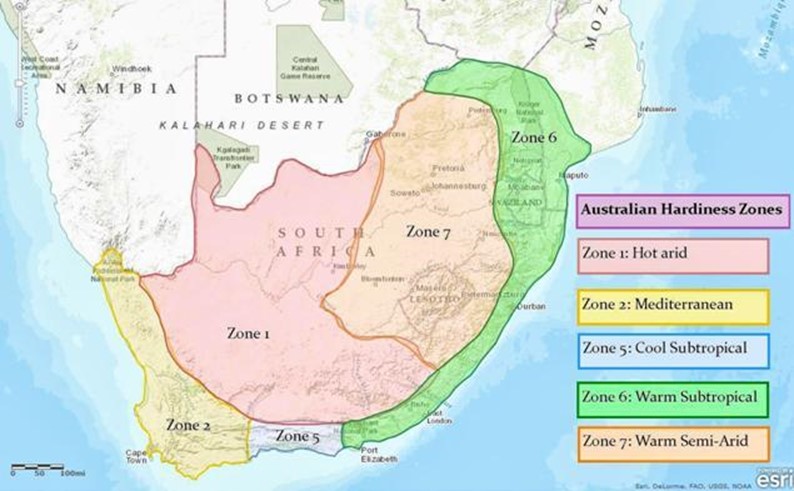
Much fruit growing is practiced in the valley to the east of the Cape Town. The size of farms in these areas varies from 20 to 120 hectares. Grapes for wine are dominant fruit crops, with small areas of citrus especially along the breed river valley. On the cooler higher plateau of the interior other fruits dominate. These are deciduous fruits which include peaches, plums, pears, table grapes, apricots, prune and apples.
The importance of fruits to South Africa economy can be judged from the fact that citrus fruits contribute 10% of the total export. Citrus fruits with deciduous fruits and wine exports contribute about 20% of all its exports.
The republic of South Africa has nearly 10 million citrus trees cared for by 4200 growers. Many of these growers are members of citrus fruit co-operatives. There are 45 such co-operatives in the country. These growers have their farms in Cape province.
There are large plantations in northern and eastern Transvaal and in natal owned by whites. There are variations in production between the provinces. The Cape Province produces between 20-25 percent while the Transvaal produces about 65% of the total production. Much of the remainder comes from natal.
South Africa trades with a number of partners who are interested in her fruits and fruit products including hard and soft drinks, and jam among others. Britain is one of the partners who import about 30% of the republic’s fruits. Others include scandnavia, Germany, Netherlands, and Belgium. These take smaller amounts.
